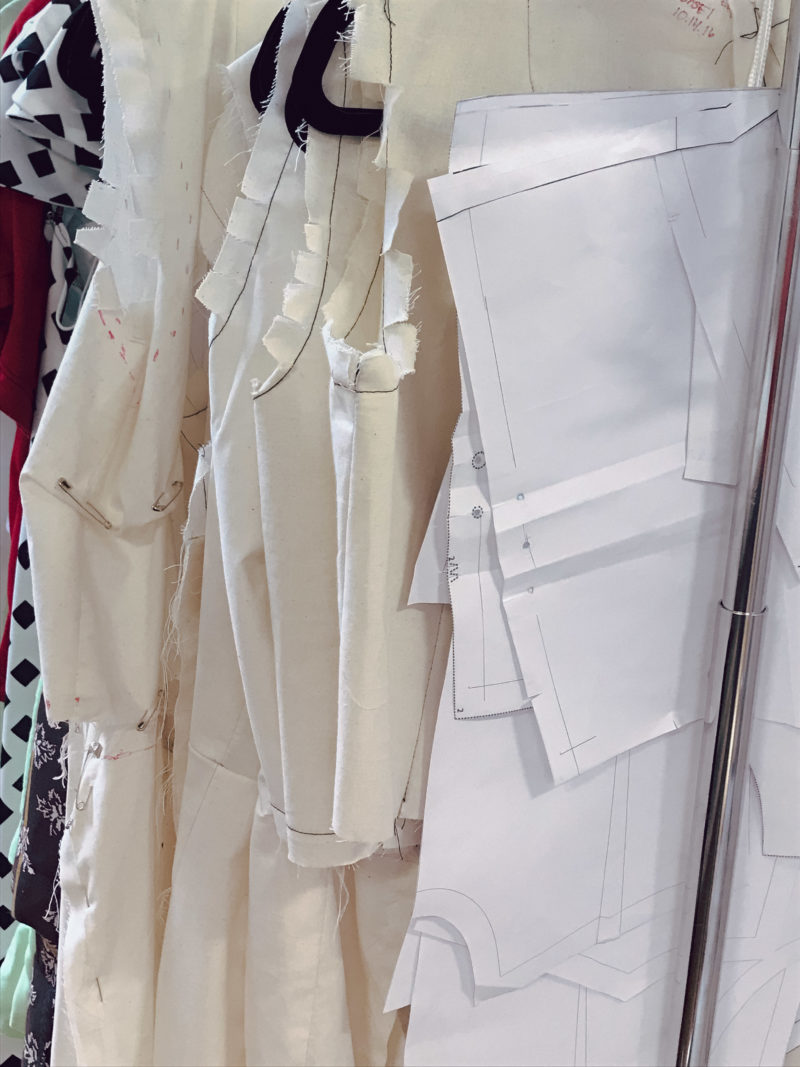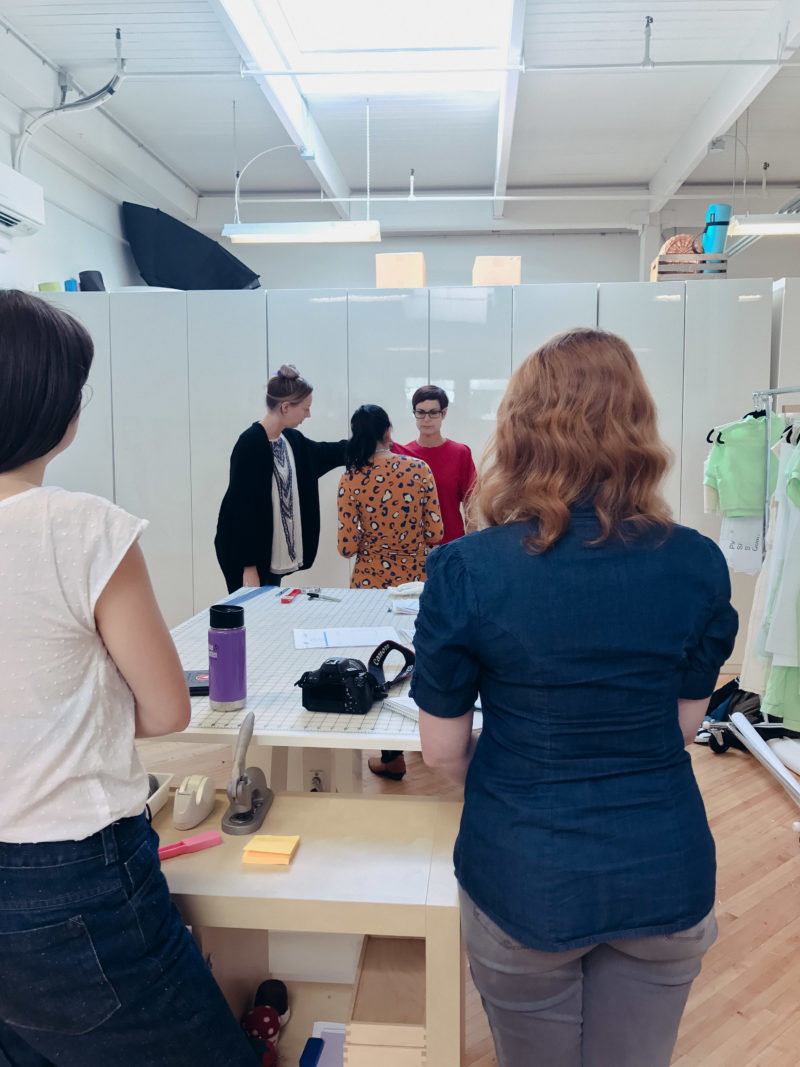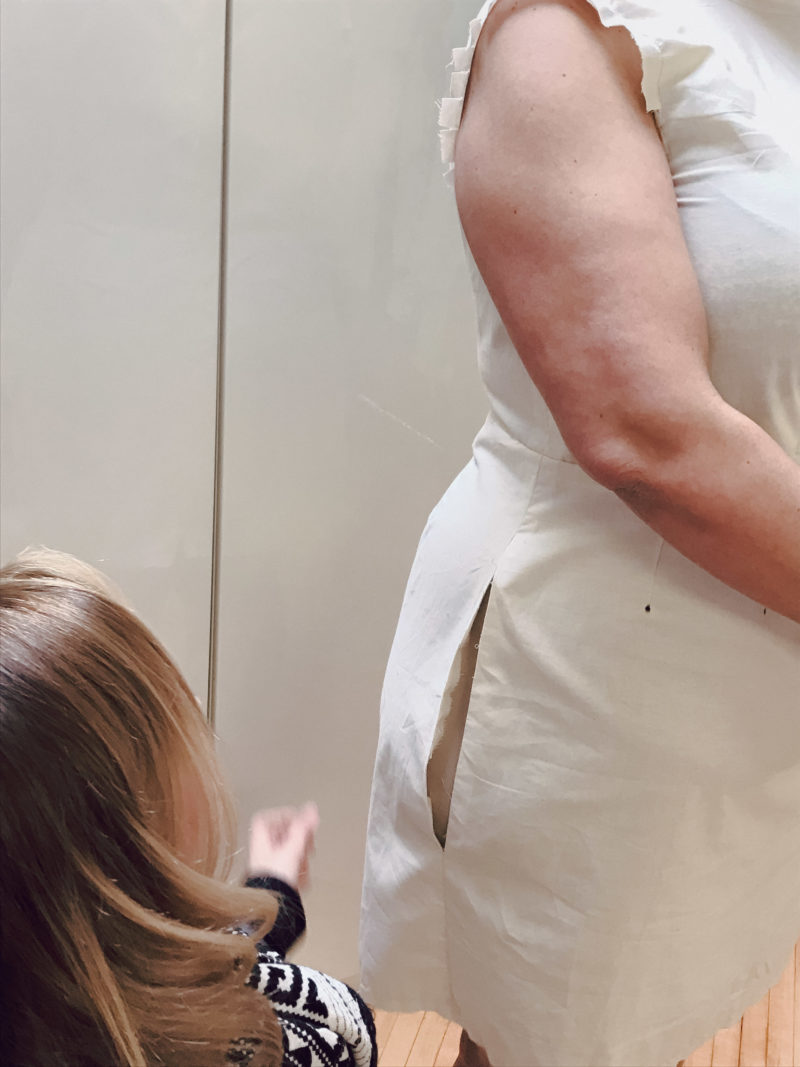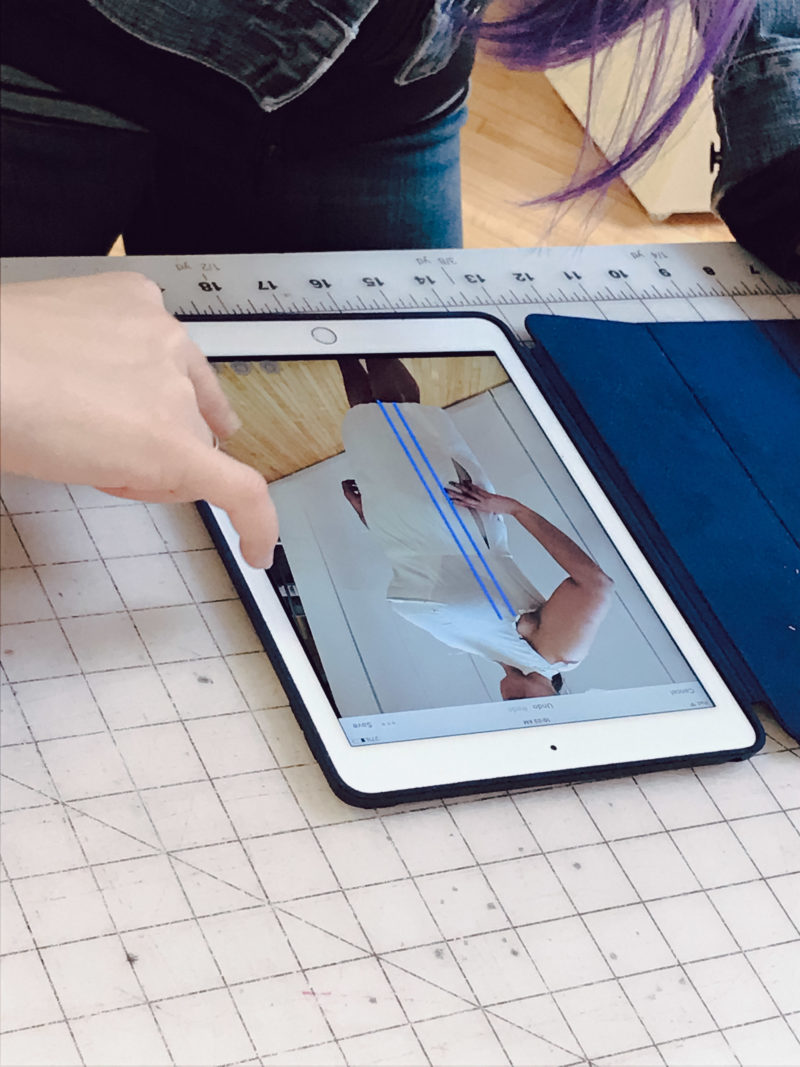Process diary: Effective Fittings
In my last process diary, I talked about refining our blocks and mentioned that the most vital component of this is the actual fitting process: taking what has been engineered and testing it repeatedly to refine the fit.
Fitting is part art and part science, which is what makes it so tricky. Although there are hard standards you can look for (pulling, drag lines, immobility, for example), some of it is a little subjective. Does it match the intended design just right? Does it look good?
Being able to work as a group to define what a good fit is, to train ourselves to rigorously address all the problems, to find ways of more efficiently testing things – these are all important issues that we’ve worked on, and that I’m sure will continue to evolve for years to come.
Here are some of the lessons we’ve taken so far. Many of them should also be helpful to you in your own fittings at home, I’m sure!
Plan it out
In the past, we’ve scheduled fit sessions whenever a pattern was ready for another test, going through repeated rounds of testing whenever changes from the last fit session were good to go.
Although this was very flexible, it meant having a lot of one-off fit sessions, often planned at the last minute.
Now, we focus on having fewer, but more effective fittings. We are usually testing multiple garments at the same time rather than just one or two. These are planned out, and never rushed. They’re more structured, and they’re more regular, so everyone knows what’s expected to be ready – from the pattern making to the sewing room.

I think another advantage of regular, longer, slower fittings is that it allows you time to get into the fitting headspace. Rather than moving through the process to get to the next step in one particular garment (adjusting the pattern so you can do another fitting), we’re spending blocks of time very focused on fit, going through the process over and over with several garments.
Defining roles
Although this one may not be as applicable to your own fitting process, another change that has been instrumental for us is better role definition.
Working in a group can be hard. Everyone has their own ideas they want to throw out there, some people are naturally more hands-on, some people are more dominant, some people are listeners, the list goes on. What’s important is having a process that is clear for everyone, not built around different people’s personalities.

So, one thing we’ve done is define better roles within the fitting. On the larger level, we’ve had to get clear about the role of the designer vs. pattern maker and who is responsible for what. At the smaller level, everyone has their tasks within a fitting. We know who is taking photos, who is taking notes, who is leading, etc.
Taking a breath
This is a tactic I’ve learned from some of my small business mentors, which is useful in almost any group discussion.
There are differences in the way people think, observe, and communicate that can cause a lot of things to be missed. It might be a matter of one person being more confident or assertive than others, or it could be that some people are best thinking on their feet, and some are more contemplative and like to observe and think things through.
To get all the perspectives and prevent a group from focusing heavily on one pet issue and ignoring others, we take some time at the beginning of fitting for everyone to look at the garment and write down what they notice. Then we go through and talk about what we observed. This takes only a minute, but it’s a great way to make sure we’re turning over every rock.
This is a really good practice to use in all kinds of meetings if you want to make them more inclusive.
Start small
In my past career, a big part of product development methodology was called “iterative prototyping.”
The idea is simple. You start with what are called “low fidelity prototypes,” which means prototypes that don’t have all the bells and whistles and functionality, but are good enough to let you test what you want to test. You learn from these, see what’s working and what needs to change, and move into more and more realistic prototypes as you learn more.
For example, say you are designing a website. You might start with a hand drawn series of sketches or storyboards and get feedback on these before moving into a digitally rendered version, which you would test before making a functional site to test out.
I borrowed the language from this development process, and we’re now incorporating more of these early “low-fi” prototypes in our process.
Our senior pattern maker has shown us a lot of techniques for creating these early prototypes, which she says are one of her number one tools as a pattern maker. They give the pattern maker immediate feedback on what is working and what is not, before going through the expense of a full blown sample and fit session.
An early “low-fi” prototype might include cutting out pattern pieces and pinning them in place on the dress form, or sewing up just part of a sample to see how it’s working. The great advantage to this is quickly discovering the larger and more obvious issues and resolving them quickly, leaving fit sessions for hashing out the tweaks.
Seeing with your hands
Another big change we’ve taken away from working with senior pattern makers these last few months has been getting more and more more done within a single fitting by using more hands-on techniques.
Hands-on approaches are always a part of fitting. We cut prototypes apart, pin things in place, and open up seams and rearrange pieces on the model. But by focusing more on these steps, we’re able to work with the pattern in a more immediate and tactile way, finding solutions over the course of a longer fit session, rather than several smaller ones.

It almost looks a bit like sculpting when you watch it in person. It takes the best of both approaches to pattern making: flat patterns to create the design, and draping techniques to help refine it.
Visual documentation
We’ve long used fit sheets to document all the changes we need to make, but we’ve gotten a lot more creative with documentation.
Lately, we’ve been using Evernote on an iPad to take photos of the garment on the model, and write notes directly on the photo of where changes should be made.

It is a really quick and easy way to take visual notes, and we highly recommend doing this at home. You can use a tablet, or use your phone.
The other advantage is that you can sometimes see things in photos that your eye might just glance over in person. One of the interesting quirks of our brains is that we will often ignore small details that our brain perceives as unimportant. But look at a photo of the same thing, and your mind has a chance to slow down and take in the details you’d otherwise ignore. If you’ve ever taken a photo that you thought would look fine, only to notice all the cords and garbage littering the background that you didn’t notice, you’re familiar with this phenomenon.
So those are some of our lessons learned about fit process. I’ll be writing more process diaries coming up: on documentation (I know, sounds boring, but it’s great), using CAD, and testing. Let me know if there are other process-y type things you’d like to hear about.

 Sign In
Sign In

Comments
Diana
November 29, 2016 #
We always said “the tape doesn’t lie” in our music classes, and it’s so true. When you’re playing the music, you know the effect you’re trying to acheive, so you hear the good and tune out the bad. When you’re listening to the recording, all the mistakes, tempo changes, or too-subtle-to-notice things come across (or don’t!) so clearly. You’ve just described the sewing version of it–love it!
I also love that you have your people write down their thoughts before anyone talks. I read about this in a book called Thinking: Fast and Slow which you might enjoy parts of. The power of someone just mentioning something to change what I intended to say or do is stronger than most people realize :)
Sarai
November 30, 2016 #
I’ve had that book on my library list for a while now!
That’s a great analogy to music also. So interesting. I found this when I started recording our podcast, too.You are suddenly painfully aware of all your verbal tics, and you can’t un-hear them after that!
Diana
December 6, 2016 #
Ha! I’ve never met anyone else who has heard of that book! :) It’s a long one, and I got bogged down about 2/3 of the way through (I found out it was keeping me awake if I read it at night) but it’s so easy to read and he presented a lot of information that was totally new to me. I think as a business owner it would apply to a lot of things you encounter every day, especially in decision-making.
And I think you sound great on the podcast!
Susan
November 29, 2016 #
I find these process diaries fascinating on many levels, and I’m just sewing for myself. Thank you for putting all this into words, and sharing with us Sarai.
Sarah-Marie
November 30, 2016 #
I am a software engineer and I have always drawn parallels between software dev methodology and sewing methodology. Awesome practice, Sarai!
Josie
November 30, 2016 #
When you say ” An early “low-fi” prototype might include cutting out pattern pieces and pinning them in place on the dress form, or sewing up just part of a sample to see how it’s working. The great advantage to this is quickly discovering the larger and more obvious issues and resolving them quickly, leaving fit sessions for hashing out the tweaks.”
Does that mean you weren’t doing this before?
Sarai
November 30, 2016 #
No, I’d say we’re just more systematic about it now. Rather than deciding each time we make a pattern what kind of prototype we need to test at that moment, we have a structure in place to create increasing levels of fidelity at each stage. Our senior pattern maker has also shown us some very specific techniques she uses to do this which we weren’t using before, from her experience in the apparel industry as a fit lead.
Coby
November 30, 2016 #
As a student of the pattern making skill, I absolutely LOVE these posts! Keep them coming — the more detail the better!
claudia
November 30, 2016 #
I never knew all the different processes that go into developing a pattern ! Your articles
remind me of my college days of math/science lectures and actual hands on lab work.
Valerie
November 30, 2016 #
Loved the evernote idea!
Sarai
November 30, 2016 #
Me too! Autumn, one of our sample makers, started using Evernote to record any issues she came across when making fit samples. Then we started using it for fit sessions too, rather than just taking photos and adding them later to the fit notes.
I love Evernote!
Monica
November 30, 2016 #
What a timely post! I just got out of a 2 1/2 hour fit session at work… :D
I feel like role clarity is so important… I always wish there was more of it. It’s very hard to be a technical designer/patternmaker at large companies these days because everyone is wanting to control the fit.
Thanks for this peek into your process!
Sarai
November 30, 2016 #
That’s probably true everywhere! It’s just so hard to draw a clear line between what is design and what is engineering. I’m sure that’s true in many other industries too. I’ve read a lot about the auto industry, and you definitely see the same kinds of challenges there too.
Diana
November 30, 2016 #
This was fascinating!! I’d been anxiously awaiting this post and I think there’s a lot of interest in the methodical approach, particularly with this sewing community. How cool to hear the kind of technological tools you’ve found useful! Making pics part of the documentation is a vital piece that’s been missing from my process.
It’s also really great to hear about how you guys work collaboratively. It’s vicarious enjoyment for those of us with non-sewing professions. Most companies are a black box and you don’t know what happens, but product comes out. It’s also gives us a greater appreciation for all the effort that goes into every product.
I would love to hear more about how you prioritize fit issues, and what kind of concerns you face when you’re designing for something to be used by all kinds of body types. I’d love to hear more about why you decided to start this process of remaking your blocks! What are you hoping to achieve with this new set?
Okay, long post, but I think 90% or more of the people that sew have to alter their patterns. It’s a really long and tricky process, even if you understand the theory. Any insight would be useful to a lot of the sewists out there. Thank you!!
Deb
November 30, 2016 #
There were so many good ideas and insights in your post! Ideas for teamwork, leadership, problem-solving, project management, and oh yeah, pattern fitting. I dabble in a number of teaching and creative arenas and could see connections in every paragraph. Thank you for sharing your process and energizing me!
Karen
November 30, 2016 #
This was helpful and informative.
I have been spending more time working on fitting garments and making more intricate garments, and enjoying it immensely. I have been making some, if not most, of my clothes since I was about 10.
You gave a great description of your process. Planning definitely helps make better use of your time. And, I love the focus on inclusiveness and asking people to make not of their thoughts before anyone starts talking. It makes so much sense. I am going to use that idea in my own work as a mechanical engineer, and suggest that others use it too.
I think understanding roles is also important. If the team talks about who is to do what, it helps the process work better for everyone.
Jenny Sandoval
December 3, 2016 #
Hey, Sarai (and everyone else!) This is all very fascinating and beyond where my artistic talent lies, but when it comes to fit, I have a wish from Seamwork and Colette.
See, I’ve never used a Big 4 pattern; I started on and still use indie-only. That’s a personal preference for me. I gravitated towards Colette because of the C cup bust, as opposed to the standard B cup; thus, lessening how much hacking I have to do for my 32DD cup.
What I’ve noticed lately — and what I’ve heard about Big 4s — is patternmakers making patterns that go up to a DD cup i.e., I could cut a size 0 and still choose a DD cup for the bodice portion. I truly wish as a busty-pattermaking company you’d offer this cup size in all sizes and not just plus-size.